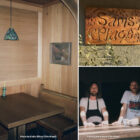
If you keep your fingers on the pulse of restaurants in Los Angeles, you’ll probably know that Baroo has been named Restaurant of the Year by LA Times restaurant critic, Bill Addison.
In September 2023, Baroo opened in the Arts District. However, the restaurant has gone through many iterations since it opened in 2015 in a rundown strip mall in East Hollywood, next to a 7-Eleven.

Founded by Kwang Uh and his former business partner Matthew Kim, Baroo focused on fermented dishes with experimental flavors. They used ancient fermentation techniques that were based on Buddhist teachings.
Kwang grew up in Seoul and worked in different restaurants around the world to broaden his experience. Before settling in LA, he worked in the Bahamas, NYC, Italy, Denmark and Spain. While Kwang still lived in Korea, he reconnected with Matthew, whom he originally met in a Korean culinary school, and who was living in Los Angeles. The rest is history.
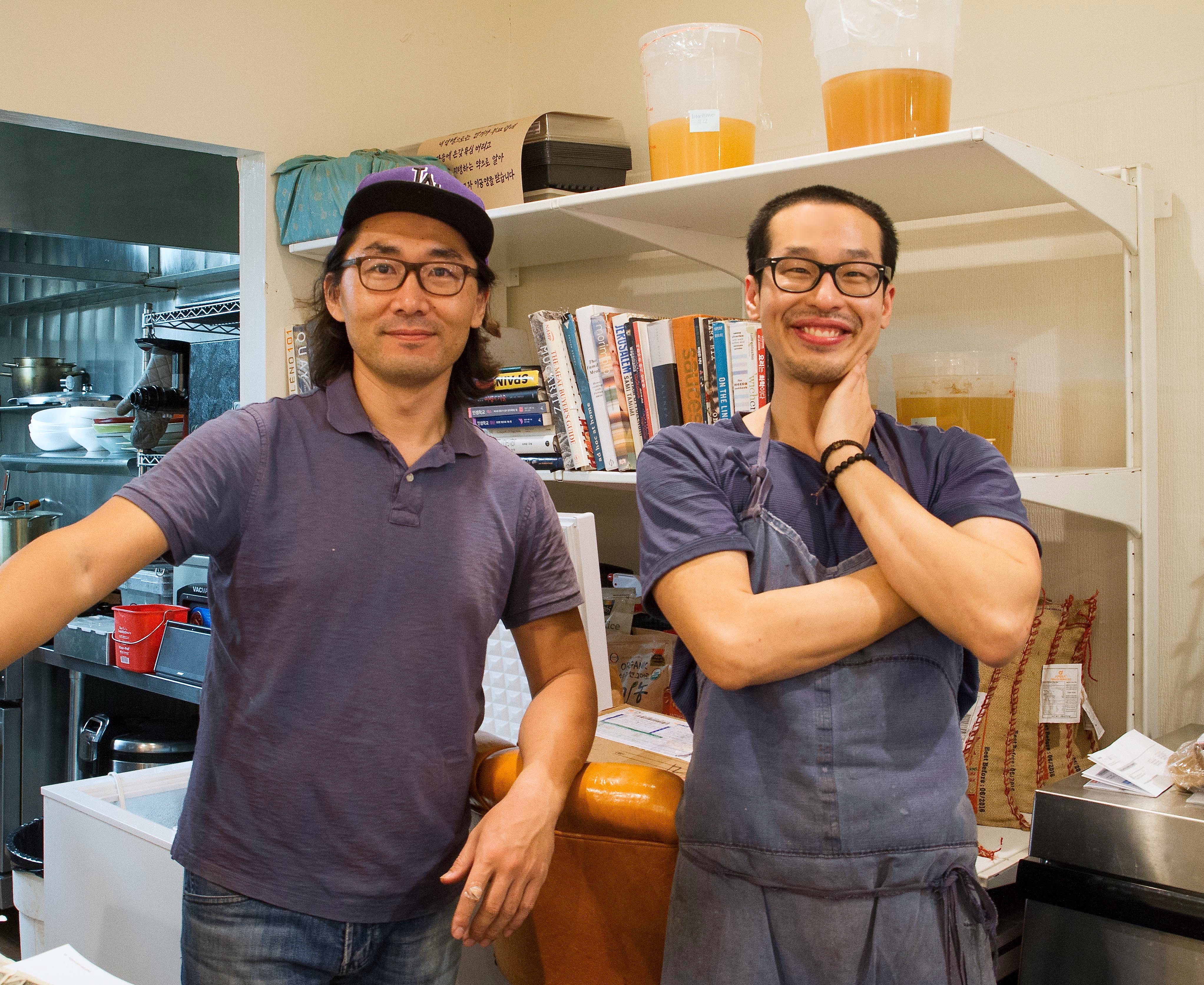
Photo by If The Devil Had Menopause
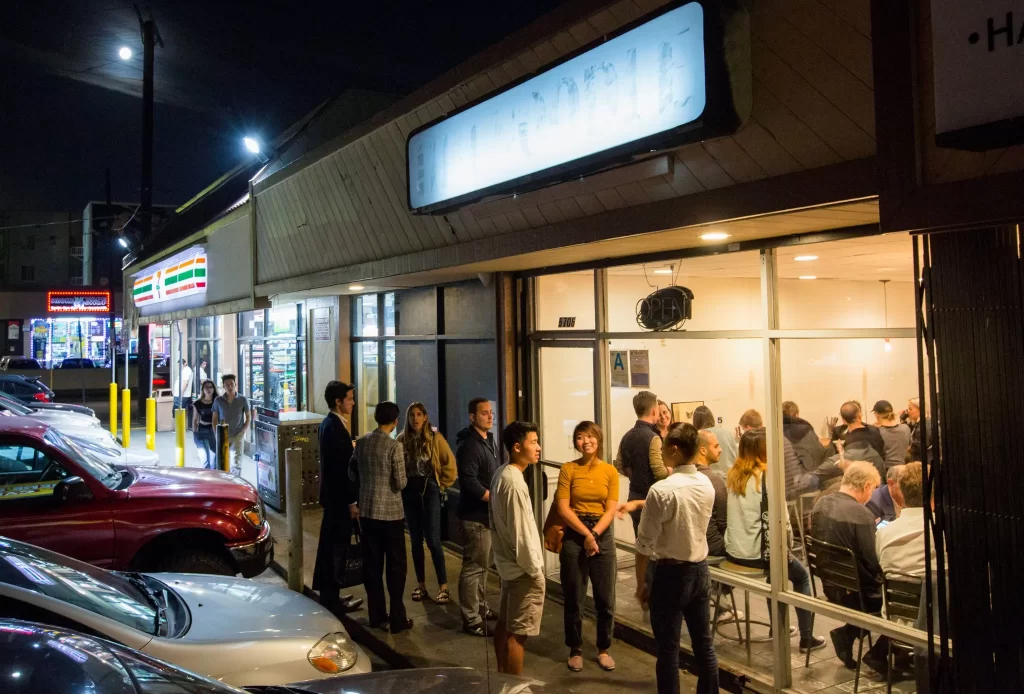
From 2015 until its closure in 2018, Baroo became a national sensation. Many have said that the original Baroo was too good to last forever. The restaurant was solely operated by Kwang and Matthew without any employees, and the menu offered elevated dishes between $9 and $15. The decor was so minimal that they didn’t even have a signage outside. Inside the restaurant, there was a shelf with fermentation containers, which resembled a scientist’s lab.
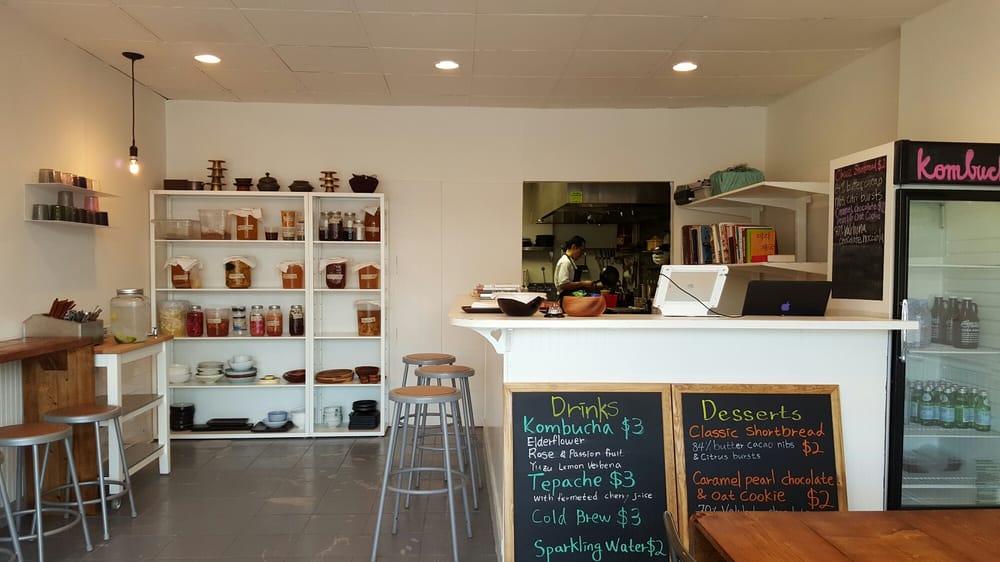
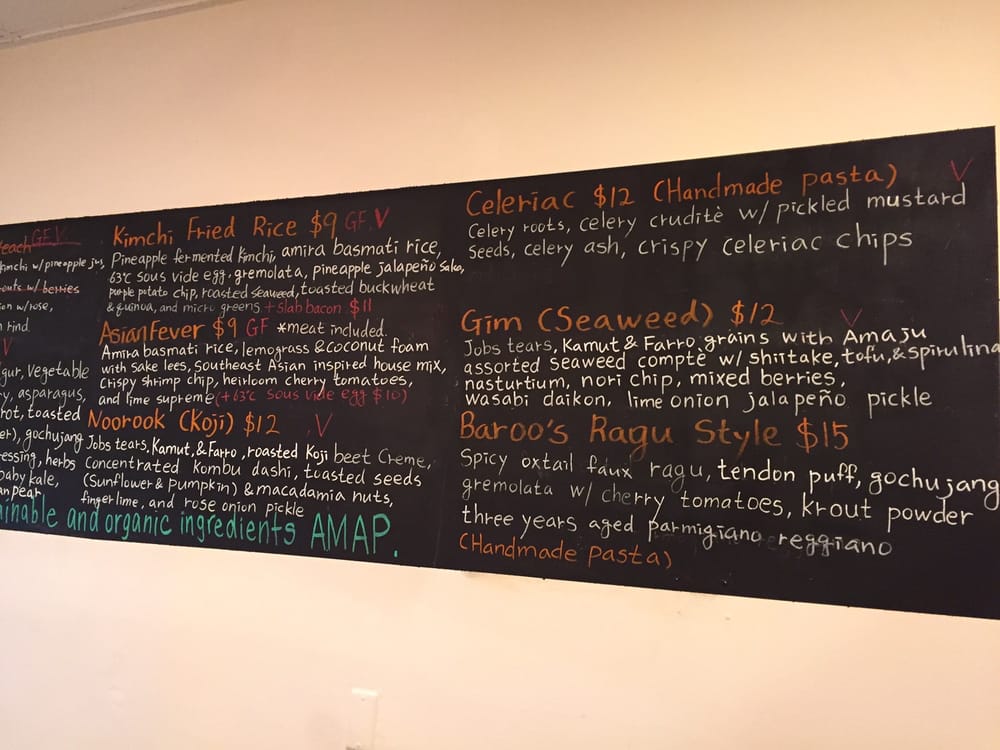
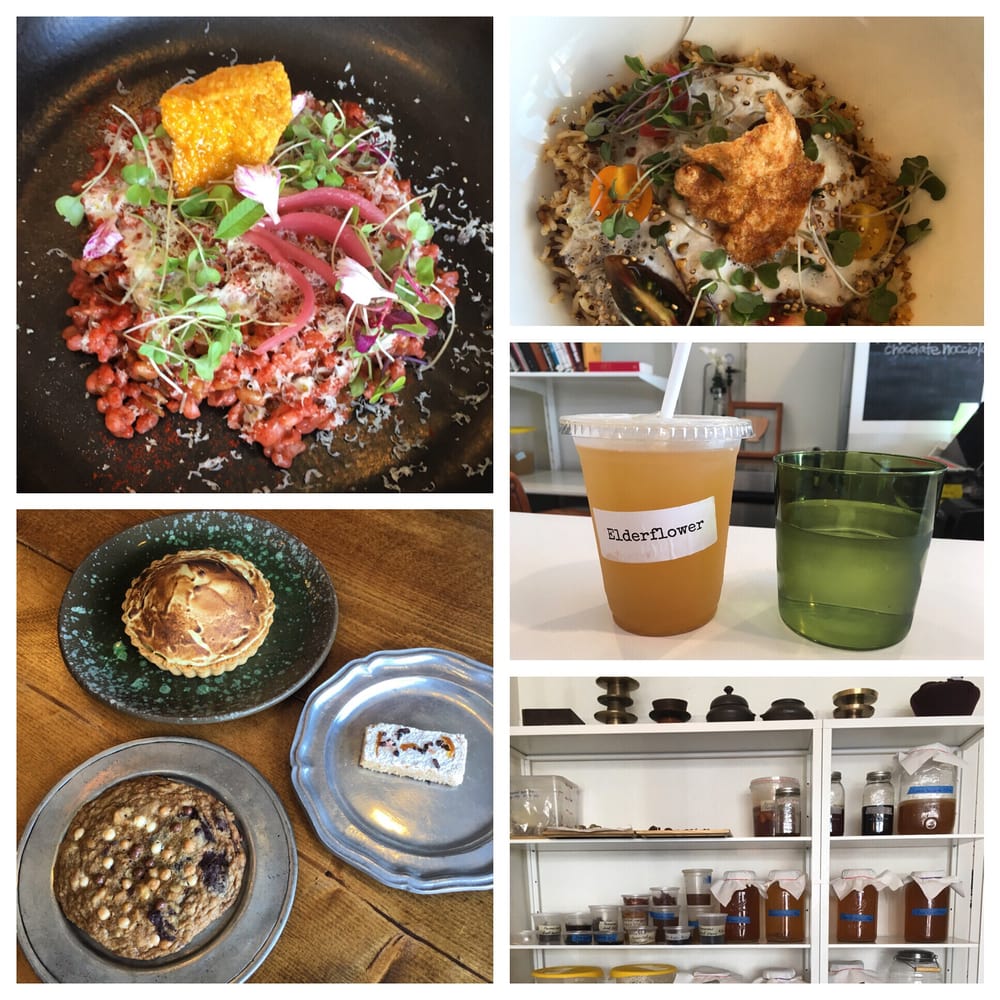
In 2016, Baroo’s $9 Kimchi Fried Rice was voted “Best Dish of the Year” by Bon Appetit magazine. That year, the magazine also ranked Baroo the fifth best new restaurant in America. In 2017, the restaurant was featured on Jonathan Gold’s LA Times “101 Best Restaurants” list. If this isn’t enough, their Kimchi Fried Rice was lauded by Condé Nast Traveler magazine as the best rice bowl in LA. Wow!
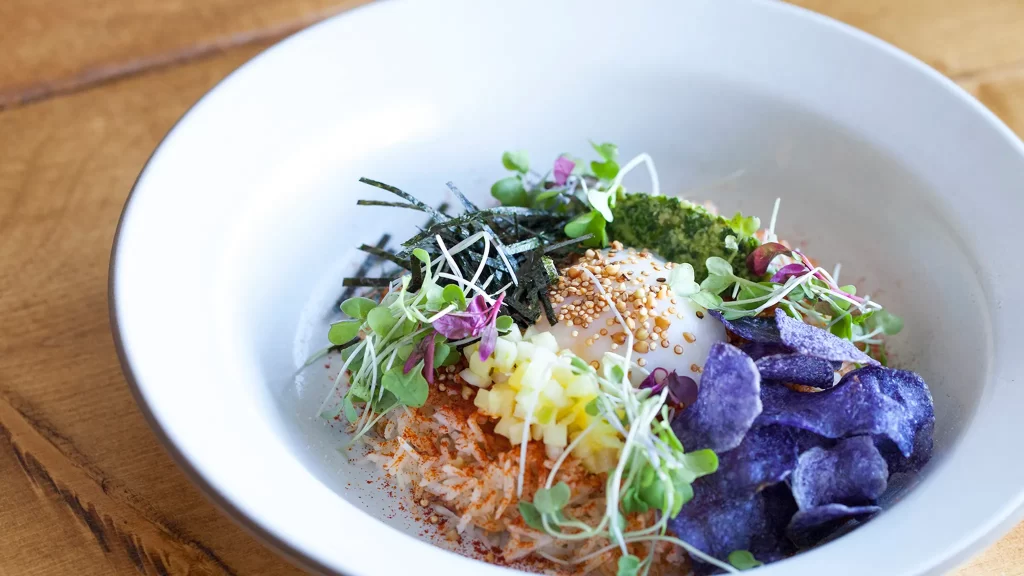
In an interview with Los Angeles magazine in 2018, Kwang said: “The name “baroo” comes from Korean Buddhist tradition, and the Buddhist approach to cooking, with its focus on connectedness and energy. It’s something we try to keep in mind.”
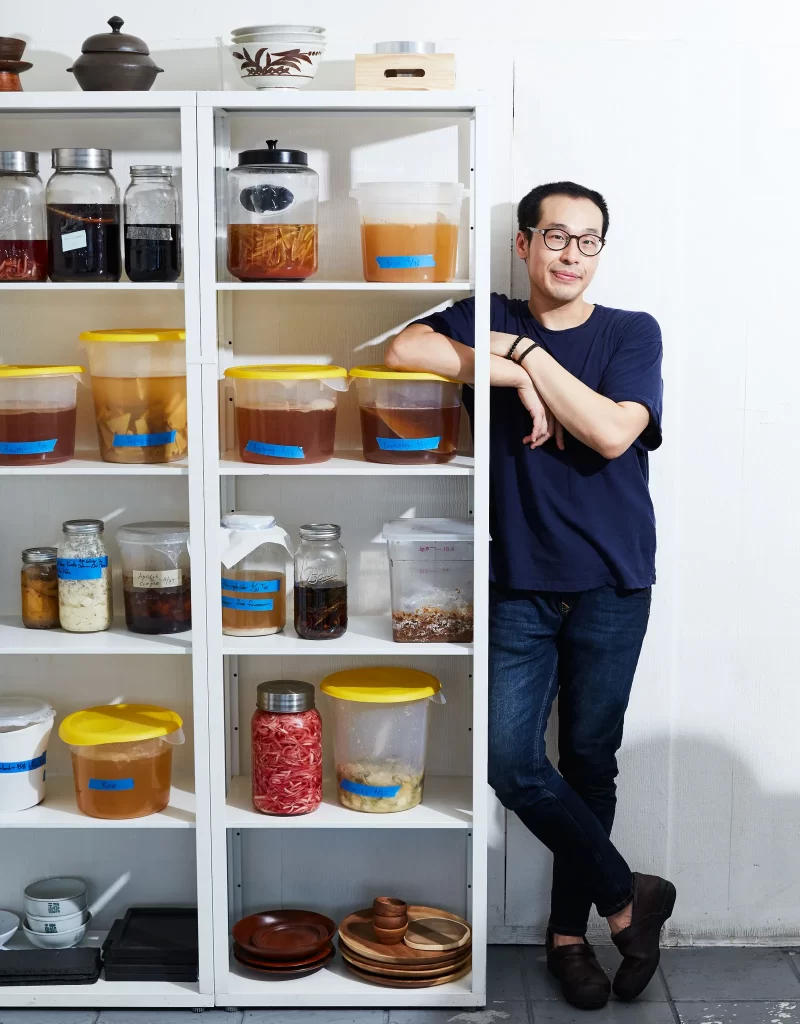
In 2018, after three wildly successful years, Kwang decided to close Baroo. According to an interview with VoyageLA in 2021, he felt like he was starting to be driven by his ego.

Kwang moved to a Buddhist temple in South Korea, where he lived for six months. This is where he met Mina Park, a former Korean lawyer turned chef. At the time, Mina was living in Hong Kong, but she uprooted her life and followed Kwang to Los Angeles, where she has partaken in his business endeavors. The couple is now happily married and welcomed a baby during the pandemic.
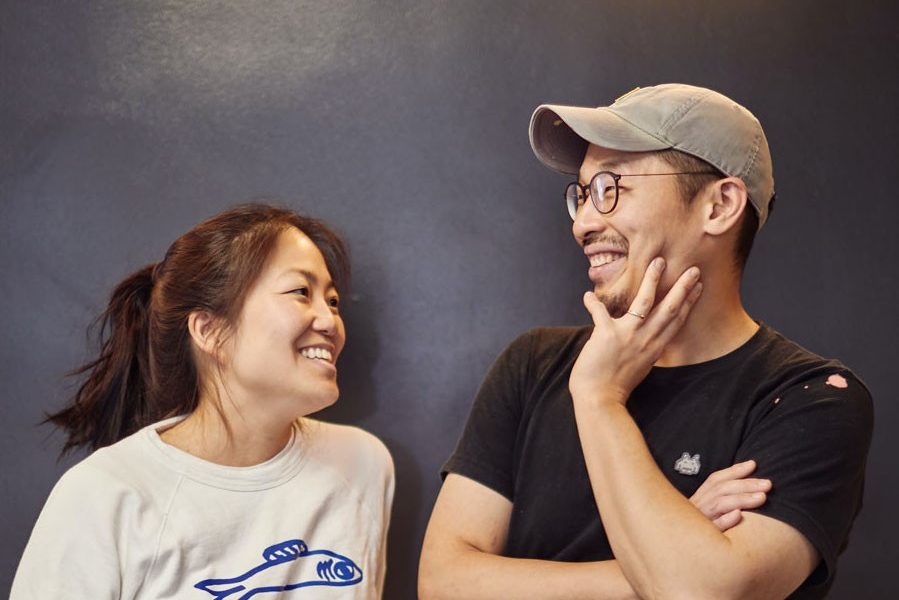
In 2019, Kwang and Mina opened Baroo Canteen, a nine-month pop-up in East Hollywood. Longtime fans of Baroo were sad when it closed, but Kwang and Mina had future plans to open a restaurant in April 2020 called Shiku. However, the pandemic put it on hold. In 2021, they finally opened Shiku in DTLA’s Grand Central Market. This fast-casual restaurant offers comforting Korean lunchboxes inspired by Mina’s and Kwang’s childhood.
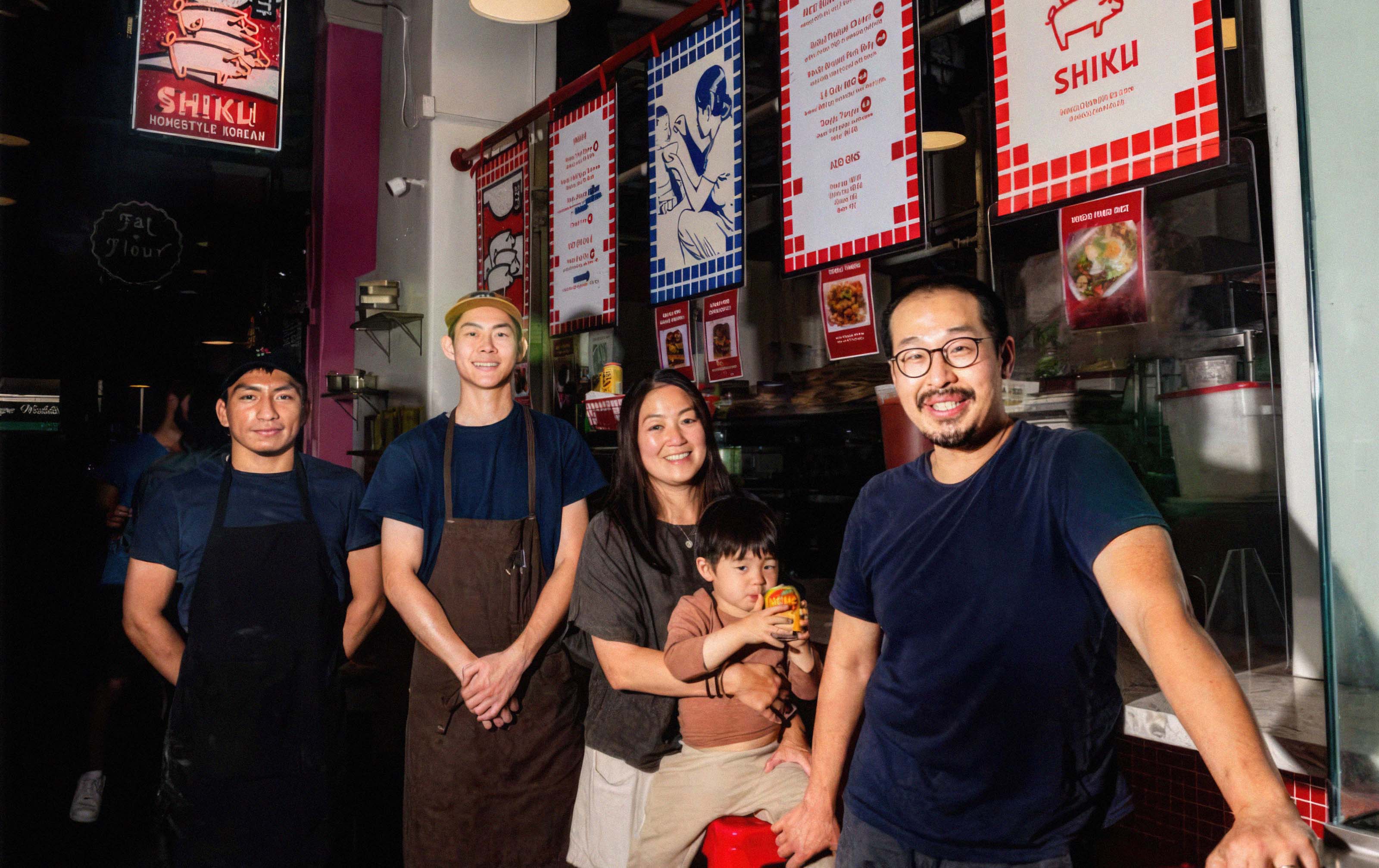
In the next few years, Kwang hinted at the reopening of Baroo in different interviews. Fast-forward to September 2023, Kwang and Mina opened Baroo 2.0 in the Artst District. The glowing reviews began pouring in and fans flocked to the long-awaited restaurant opening.
The interior of Baroo 2.0 is a far cry from the modest former space in East Hollywood: high ceilings, an open kitchen bar, warm wood accents, pendant lights made out of seaweed, and uniformed servers taking care of every detail. I was the first person when I went there but when I left, the place was packed!
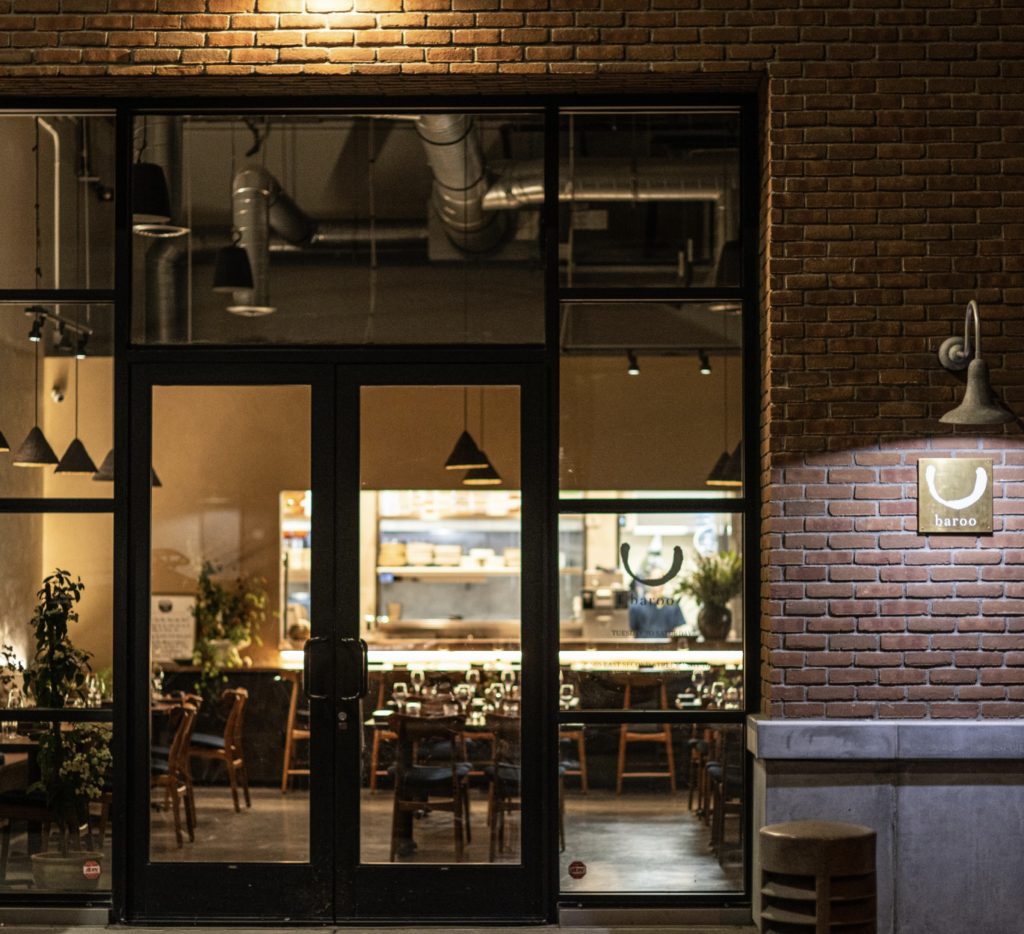

The prix fixe menu is $115 and includes a seventh-course meal centered around Buddhism and the cycle of life: from birth to death.

Baroo also offers a vegetarian menu, but it needs to be requested 24 hours in advance. Upon ordering, they’ll ask you if you have any allergies or dietary restrictions.
Each dish had a description of the ingredients, alongside the Buddhist life cycles. Since many of the ingredients were in Korean, I will list the menu items by course number.
First course

This was a small appetizer to prepare your taste buds for what was about to come. The seed puff was thin and crispy with a perfect crunch, and packed with nutty flavor. The Gazpacho-style soup was made of watermelon, lemon, tomato and Kombucha. Not only was it refreshing, but every sip was a burst of flavors; sweet and tart with sour notes. I could have drank a gallon of this. Make sure you dip the seed puff into the soup to amplify the flavors and textures.
The round white plate had a bite-sized spongy bread toast called “sool bang”, made with black sesame and topped with shredded gouda cheese, pichuberry (fruit), and nduja, which is a spicy paste made of pork sausage – very typical in Italy. Here is a slightly better close-up.
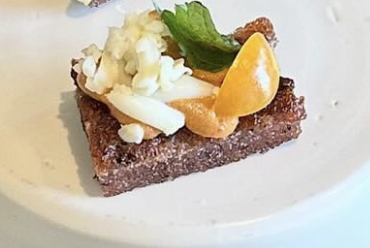
This was one of my favorite bites of the night! Sweet, tart, herbal and spicy with the chewy texture from the spongy bread. The leaf, with its minty aroma and earthy flavor, was a great finishing touch to counteract the mildly spiced paste. The toast is eaten in one bite, so make sure you take the time to appreciate the flavors.
Second course

Scallop topped with puffed wild rice in a seaweed soup infused with microgreens. The scallop was fantastic – tender and perfectly seared – but the soup was too herbal for my liking. The puffed wild rice added a subtle crunch, and there were cubed bits of seaweed jelly in the sauce. These were nice adornments to play with different textures but ultimately, failed to add any depth to the dish.
Third course
Beautiful presentation. The crispy center is battered sole fish with parae gim, a type of Korean seaweed – topped with a drizzle of thick herb paste and studded with edible flowers.

The delicate Korean ssam lettuce gently hugged the fried batter, which was crispy and crunchy on the outside, with a deliciously tender fish on the inside. Although the paste was very thick, it elevated the flavors and the soft texture of the lettuce wrap and the crunchy battered fish. I don’t think I’ve ever had lettuce as soft as that one.

Fourth course
This was by far the most memorable dish of the night. What a commendable amalgamation of flavors and textures.

The soy braised black cod is bathed in a warm buttermilk lemongrass sauce, and it’s accompanied with three small sides: fried green papaya sticks, radish (dongchimi) and shisho microgreens.
The buttery and tangy sauce tied everything together: the tender and flakey soy-flavored cod, the sweet crunchy papaya sticks, the velvety-soft peels of refreshing radish and the earthy microgreens. I relished every single bite. Make sure you eat every mouthful with all ingredients for a delightful combination of flavors and contrasting textures.
Fifth course
This was another dish served with a warm sauce tableside. Pork collar slices doused in a luscious Korean-style goulash sauce, with a side of kimchi and a ssam lettuce leaf. The server suggested to tear off the leaf and sprinkle it across the dish.

The glob of baek kimchi had a mild pickled taste that surprisingly, balanced the rich and comforting goulash sauce, which was the star of the show. The pieces of pork were fatty and very juicy. I’m not vegan, but I can’t recall the last time I ate pork meat, so I wasn’t accustomed to its strong flavor. This Korean-style goulash (jjigae), is typically cooked with pork meat and other vegetables.
When I lived with my mother, sometimes she would cook goulash (beef stew), which was very hearty and comforting. I’m being biased, but beef has a nice balance of lean and fat, and would have paired better with this sauce.
With this being said, the pork can be substituted for braised short ribs for an additional $12, but you’ll get a different sauce.
The ssam lettuce was the same type of lettuce that was served on the third course – it was very soft and added a subtle layer of herbal flavor without being too overwhelming. Despite the stark difference in flavors and temperatures, it was a harmonious blend.
Sixth course
Even though the rice was served alongside the pork collar dish, it’s listed on the menu as a different course.
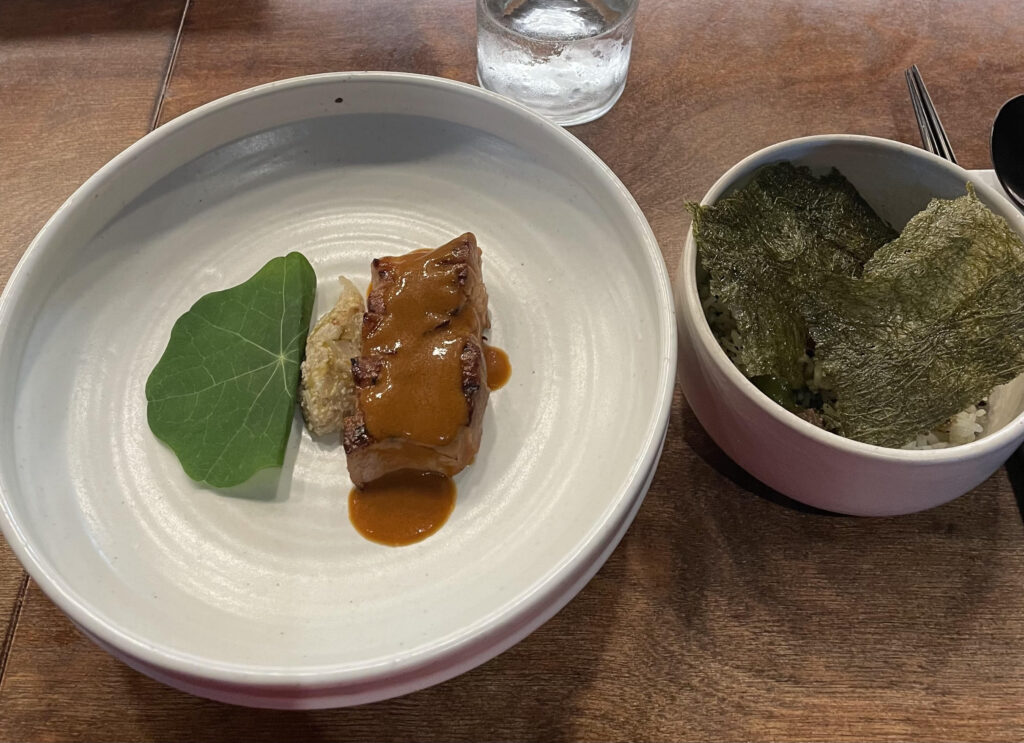
The Wild Mountains Green Rice consisted of perilla leaves, xo sauce (a dried condiment made of dried shrimp and shallots), gamtae seaweeds and lotus sunchoke root.

I stirred it and proceeded to take the first bite. The most noticeable ingredients were the long-grain rice, herbs, and crispy seaweed with hints of spice from the xo sauce. I missed the intricate combination of flavors from the previous dishes. This one was just ok, not memorable. The rice with herbs is served from a huge rice cooker, so it was a generous portion. I don’t know if you can appreciate it in the picture above, but the rice was on the dry side, which was a disappointment because rice is the foundation of this dish. The grains were slightly hard. Since I was going to be paying $115, I ate all of it — but I couldn’t wait to finish it and move on to the next course. There’s a photo of this dish on Baroo’s Instagram page, where you can see the rice looks moist and fluffy.
The green sauce underneath was made from the perilla leaves, which was rich and earthy. Unfortunately, this sauce was overpowered by the massive seaweed sheets that took over the bowl.
Seventh course (dessert)
Almond sikhye (fermented rice and malt), black sesame seeds, shaved ice and peach sorbet from Andy’s Orchard.

The shaved ice was made with a machine imported from Korea. The delicate ice particles were so fine they evaporated in my mouth. Besides the elegant presentation, the standout of this dish was yet again, the marvelous way all the textures melded together: the finely shaved ice, the thick consistency of the sweet almond sikhye, and the nutty crumbs of sesame seeds. Then, a scoop of icy and smooth peach sorbet lay at the bottom of the bowl. The peach is from Andy’s Orchard, one of the best farms in California. It felt like I was eating a juicy, ripe peach but in a sorbet form. What a treat!

This dessert was a nice palate cleanser to end the meal.
Service
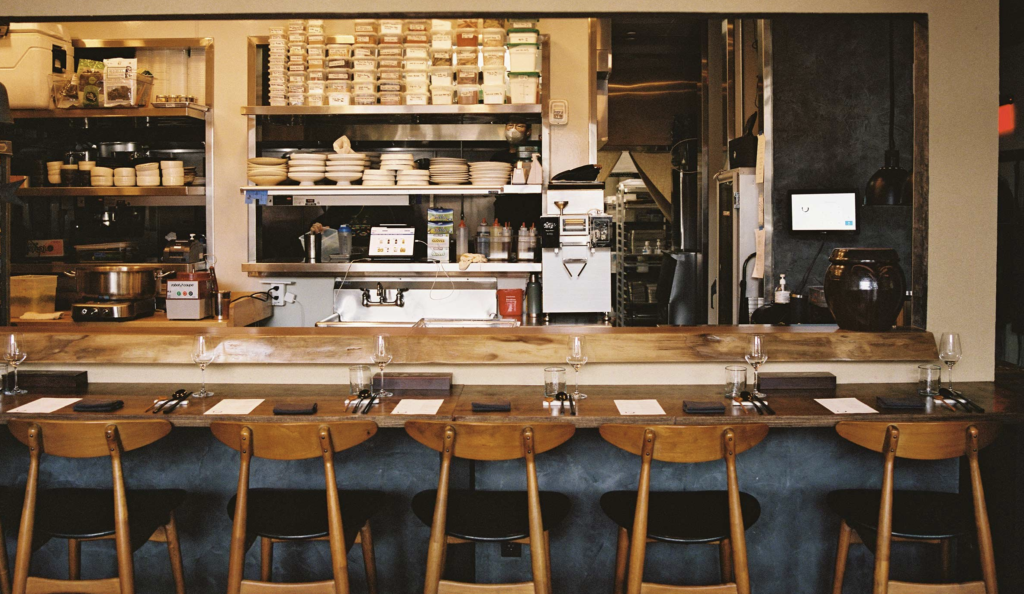
When I think of the most memorable meals I’ve had in Michelin-starred restaurants, hospitality is a big part of the experience. If I had to rate the service at Baroo, it would be a 5/10. My cup of water was always filled up and they ensured that the counter was pristine after they took the plates away. However, the service lacked personalized attention and friendliness.
Many people will think I’m nitpicky, but for $115 a head, I would expect a short greeting upon being seated. “Welcome. Is this your first time dining with us?”, “Here’s a breakdown of the menu”, which didn’t happen.
A few staff members were wearing face masks, which hindered their communication. As one of them was serving my plate, he described the dish, but all I could hear was a muffling sound. I asked if he could repeat how a certain dish should be eaten, but I felt he was a little annoyed. He was holding a pitch of water in the other hand and seemed to be in a rush to get to the other tables.
I had to rely on the menu to know what I was eating. Despite being the first person dining at the restaurant, no one checked in on me throughout the meal to see how I was enjoying it or if I needed anything. I was left to my own devices. Could this be because I sat at the bar counter?
As I was about to leave, a staff member walked me to the door and thanked me for coming with a smile. Given the staff’s serious demeanor, I was very surprised. I’ve watched a few videos of Mina and Kwang, and they seem very nice and approachable. In an interview with the LA Times, Mina said that they wanted to create an inviting and warm atmosphere, but I felt the complete opposite.
When reading the reviews about the service, someone mentioned that the staff was masked up, and the ones that weren’t were on the introverted side. However, other people seem to have had a completely different experience, highlighting the attentiveness and friendliness of the servers. One review even said that the server took the time to explain the menu.
Another observation was the temperature inside the restaurant. It was very cold, especially at the bar counter that faced the kitchen, where you’re close to the refrigerators and thermostats. After the first course, I had to quickly ran to my car to get a jacket.
Overall thoughts
The food was a 7.5/10. Some dishes were a hit or miss. Had I had the beef ribs instead of the pork on the fifth course, I may have given it an 8.
If you’re looking for traditional Korean-style barbecue with big portions, this is not the place. After the meal, you will be fairly satisfied, but not full. I would also not recommend Baroo if you’re not into leafy greens or herbs, as these are present in almost every single dish.
Besides the artful combination of flavors and textures, the outstanding sauces are worthy of recognition. The buttermilk lemongrass sauce and the goulash sauce were exceptional. Make sure you spoon up the remainders!
Baroo’s seventh-course meal is $115. Considering the restaurant’s prestige and the wide variety of dishes you get to try, I found it to be fairly priced.
The new version of Baroo has bridged a gap between fine dining and Korean food. Despite having the largest Korean population in the United States, LA lacked a fine dining restaurant that offered a modern take on Korean food.
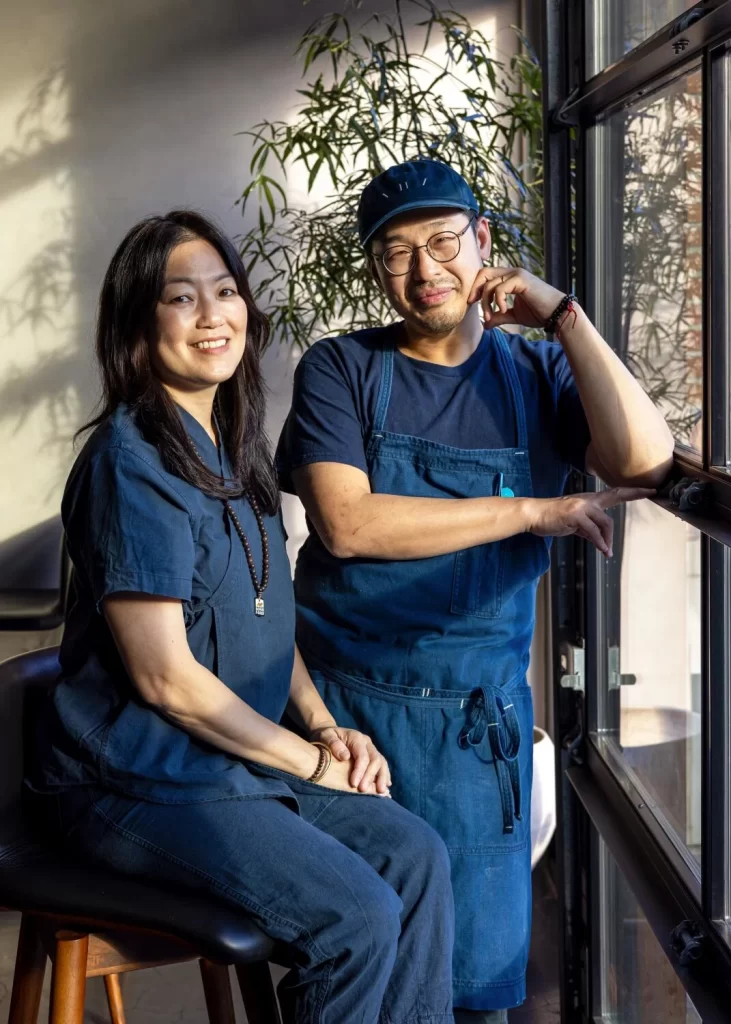
Although dining at Baroo 2.0 comes with a hefty price tag, the original essence of Baroo remains: experimental and innovative flavors centered on Buddhist teachings in a modern yet casual atmosphere. The food scene in Los Angeles has evolved a lot since 2015. A restaurant like this nearly a decade ago was ahead of the curve and certainly, helped put LA on the map as a global culinary destination.
Make your reservation on Resy here.
Address: 905 E 2nd St #109, Los Angeles, CA 90012




